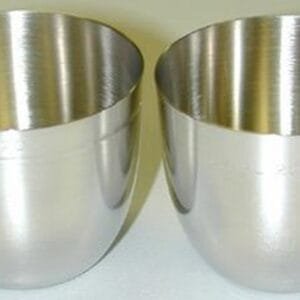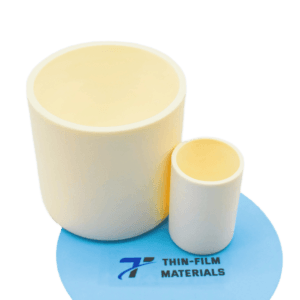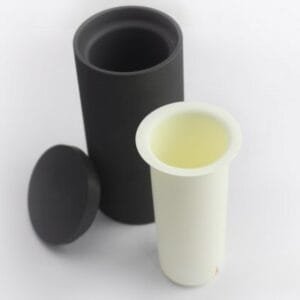Description
Iridium crucibles are specialized vessels for high-temperature applications, particularly metallurgy, single crystal growth, materials science, and semiconductor manufacturing. They are made from iridium, a rare and precious metal known for its exceptional properties. Iridium is the second-densest naturally occurring element, with a 22.56 g/cm³ density. It is extremely hard, brittle, and corrosion-resistant and has remarkable thermal and chemical stability, even at very high temperatures, up to 2,000°C.
Iridium crucibles are typically used for melting and holding materials at elevated temperatures in environments where other materials may degrade or react unfavorably. Due to their superior properties, iridium crucibles are ideal for handling reactive metals, alloys, and compounds that require precise control over temperature and purity during processing. Typical applications of iridium crucibles in research and development settings include crystal growth, thermal evaporation, chemical vapor deposition (CVD), and high-temperature experimentation.
Specifications of Iridium
Typical Chemical Compositions and Impurities (Ir>99.96%; ppm)
| Rh | 42 | Au | 3 | Zr | 2 |
| Pd | 22 | Cr | 3 | B | <2 |
| Zn | 21 | Ni | 3 | Cd | <2 |
| Pt | 18 | Os | 3 | Mn | <2 |
| Ru | 15 | Sn | 3 | As | <2 |
| Sb | 11 | Cu | 3 | Co | <2 |
| Al | 7 | Pb | 3 | Mo | <2 |
| Ca | 6 | Mg | 2 | Te | <2 |
| Se | 5 | Bi | 2 | ||
| Si | 4 | Ag | 2 |
Electrical Properties
Electrical resistivity ( µOhmcm ): 5.1@20°C
Superconductivity critical temperature ( K ): 0.1100
Temperature coefficient ( K⁻¹ ): 0.00450 @0-100°C
Thermal emf against Pt (cold 0C – hot 100C) ( mV ): 0.65
Thermal Properties
Coefficient of thermal expansion ( x10⁻⁶ K⁻¹ ): 6.800 @0-100°C
Latent heat of evaporation ( J g⁻¹ ): 3186
Latent heat of fusion ( J g⁻¹ ): 135.00
Specific heat ( J K⁻¹ kg⁻¹ ): 133.0 @25°C
Thermal conductivity ( W m⁻¹ K⁻¹ ): 147.00 @0-100°C
Mechanical Properties
Bulk modulus ( GPa ) ( Hard / Soft ): 371.0
Hardness – Vickers ( KGF mm⁻² ) ( Hard ): 650
Hardness – Vickers ( KGF mm⁻² ) ( Soft ): 200 – 300
Material condition: Hard / Soft
Poisson’s ratio ( Hard / Soft ): 0.260
Tensile modulus ( GPa ) ( Hard / Soft ): 528.00
Tensile strength ( MPa ) ( Hard ): 1200.00
Tensile strength ( MPa ) ( Soft ): 550.00 – 1100.00
Applications of Iridium Crucible
Iridium Crucibles are crucial in various high-temperature processes, particularly in semiconductor manufacturing, materials science, and research. Some critical applications of Iridium Crucibles include:
- Czochralski Method (CZ Method) Crystal Growth: Iridium crucibles are primarily used in the CZ method for single crystal growth. This technique involves melting raw materials in the crucible, touching a seed crystal to the melt, and slowly rotating and pulling it up to promote crystal growth. Iridium’s high melting point and corrosion resistance make it ideal for handling this process’s extreme temperatures and chemical environments.
- Semiconductor Wafer Production: Iridium crucibles produce semiconductor wafers, where single crystals are grown and then sliced into thin wafers for electronic device fabrication. The high purity and stability of iridium crucibles ensure the quality and integrity of the semiconductor materials produced.
- LED Substrate Manufacturing: Crystals grown using iridium crucibles, such as Sapphire for LED substrates, benefit from the exceptional purity and quality achieved through the CZ method. Iridium crucibles enable the precise control of crystal growth parameters, resulting in high-quality substrates with excellent optical and electrical properties for LED applications.
- Optoelectronic Device Fabrication: Iridium crucibles are used to produce optoelectronic devices such as photovoltaic cells, optical filters, and laser components. Iridium’s high temperature and chemical resistance ensure the purity and uniformity of the materials used in these devices, contributing to their performance and reliability.
- Advanced Materials Research: In research laboratories, iridium crucibles are employed in high-temperature experiments and materials synthesis processes. Researchers use iridium crucibles to study the properties of materials at extreme conditions and develop new materials with unique characteristics for various applications.
Packaging
Our Iridium Crucibles are clearly labeled externally to ensure efficient identification and quality control. To prevent any damage during storage or transportation, we take great care.





Reviews
There are no reviews yet.